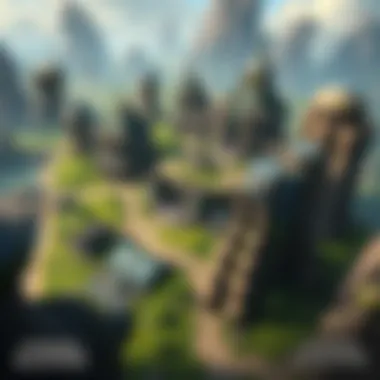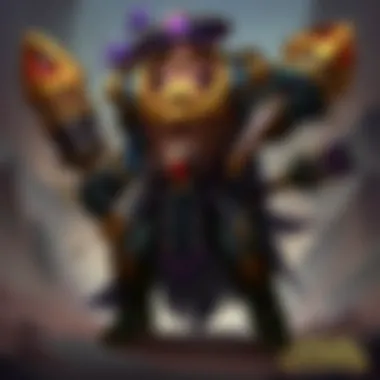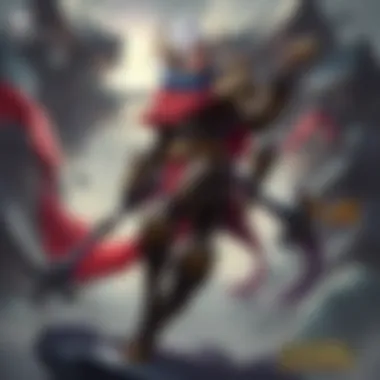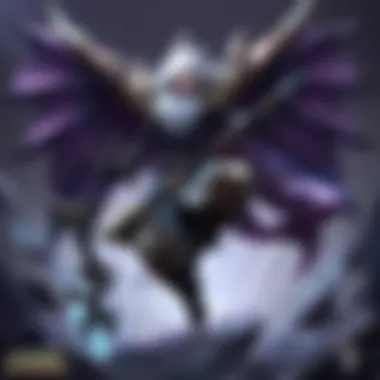Exploring League of Legends: Mechanics and Impact


Intro
In the constantly shifting landscape of multiplayer online games, League of Legends stands out as a titan, captivating millions with its strategic depth and competitive spirit. This game isn’t just a pastime; it has evolved into an intricate cultural phenomenon that breathes life into both casual players and hard-core gamers alike.
The allure of League of Legends goes beyond basic gameplay. It's about understanding roles, honing specific skills, and engaging in a community that thrives on competition and creativity. As players navigate through various champions and maps, they fall into the depths of its lore, the strategies that define victories, and the patch notes that regularly transform the meta. This article aims to peel back the layers of the game, providing insights that are valuable for every individual, whether they are a greenhorn just stepping onto the rift or a seasoned veteran looking to refine their strategies.
From champion spotlights to gameplay tactics, and community engagement to patch updates, we’ll journey through the core aspects that make League of Legends not just a game, but a living ecosystem. By the end of this exploration, readers will emerge with a more nuanced understanding of what contributes to the game’s enduring popularity.
"League of Legends is a symphony of strategy, an act of balance that requires skill, teamwork, and a touch of creativity."
The subsequent sections will dig deeper, laying out the vital components that keep players returning to the Summoner’s Rift time and time again.
Foreword to League of Legends
League of Legends has surfaced as a significant pillar not just in the realm of gaming but in the broader tapestry of modern entertainment. Understanding this game is fundamental for players and enthusiasts alike, as it embodies a complex blend of strategy, quick reflexes, and continuous personal and communal evolution. Through this exploration, readers will gain insights that are not only pertinent for gameplay but also beneficial in comprehending the wider implications of its success and its cultural resonance.
Overview of the Game
League of Legends is a multiplayer online battle arena (MOBA) where two teams of five players each compete against one another to destroy the opposing team's Nexus. At first glance, this may sound straightforward, however, the depth of strategy involved is tremendously intricate. Each match unfolds on a symmetrical map called Summoner's Rift, consisting of three lanes – top, middle, and bottom – and a jungle area filled with neutral monsters that players can defeat for gold and additional experience. Players select from a diverse roster of champions, each equipped with unique abilities and characteristics that cater to various playstyles. The champions, alongside their player roles, dictate how effectively a team can achieve their objectives within the game.
The match is defined by various key objectives, such as controlling territories, eliminating enemy champions, and pushing down turrets. These objectives create a compelling dynamic and necessity for teamwork, individual skill, and in-depth knowledge of both champions and strategies. The game is constantly evolving due to frequent patches and updates, ensuring that players must continually adapt, whether that be through learning a new champion or understanding shifting meta-game strategies.
Significance in Gaming Culture
Beyond its gameplay essence, League of Legends holds a prominent place in gaming culture, shaping communities and influencing trends within the esports industry. It catalyzes connections among players, bridging gaps across backgrounds and fostering friendships based on shared interests. Forums, Reddit communities, and social media platforms often buzz with discussions about updates, game strategies, and fan theories, making it a communal experience.
Moreover, the competitive scene of League of Legends has ushered in a new age of professional gaming. Players and teams dedicate countless hours and sweat to excel in this landscape. Events like the League of Legends World Championship draw in millions of viewers, showcasing not only the skill and dedication of top players but also highlighting the thrilling spectacle of esports. This phenomenon emphasizes that gaming transcends mere pastime; it is a legitimate contender in the arena of global entertainment.
"League of Legends has not only created expert players, but also a culture where teamwork and strategy reign supreme."
In summary, the initial understanding of League of Legends serves as a critical foundation, providing insights that transcend the mere act of playing. It encourages a broader perspective of gaming as a community-driven landscape where collaboration, competition, and culture intertwine.
Gameplay Mechanics
Gameplay mechanics form the backbone of League of Legends, serving as a pivotal element that not only shapes individual matches but also influences overall strategy and player development. Understanding these mechanics can enhance a player's ability to perform well and contribute effectively to their team. At its core, gameplay mechanics encompass game structure, champion roles, abilities, and spells. Each of these elements works in tandem to create a rich tapestry of tactical gameplay.
Game Objectives and Structure
League of Legends is built around a clear set of objectives. The primary goal in each match is to destroy the enemy's Nexus, the core structure located within their base. To achieve this, players must navigate a map divided into three lanes—top, mid, and bot—while also utilizing the jungle area. Each lane has its unique dynamics and strategic value.
The importance of teamwork and communication cannot be overstated here. Players need to coordinate their efforts, exchanging strategic information and executing well-timed maneuvers to outsmart opponents. Game structure empowers players to make tactical decisions, whether it’s to push a lane, secure objectives, or engage in team fights.
The beauty of League of Legends lies in its depth, where every game becomes a new puzzle to solve.
From the moment the game begins, each player's decisions can tip the balance of power on the battlefield.
Champion Roles and Responsibilities
Every champion in League of Legends has specific roles, contributing to the team's overall strategy. Covering the following categories—Top Lane, Mid Lane, Jungle, and Bot Lane—provides insight into how each role functions and impacts game dynamics.


Top Lane Champions
Top Lane champions are often the backbone of any team composition, usually featuring tanky or bruiser-like champions who can absorb damage while dealing sustainable DPS. Their primary responsibility is to secure their lane while provided pressure across the map.
A key characteristic of Top Lane champions is their ability to control space in lane and provide a frontline for their team during skirmishes.
- Unique feature: Many Top Lane champions can initiate fights, thanks to their inherent tankiness.
- Advantages: They can soak up damage and protect squishier teammates and also have the ability to teleport back into the fight at crucial moments.
- Disadvantages: Some Top Lane champions can become less effective if they fall behind early, as they might lack impact in team fights.
Mid Lane Champions
Mid Lane champions serve as the powerhouse of the team, often comprising of mages or assassins. They are typically responsible for dealing significant burst damage to opponents and controlling the battlefield with crowd control abilities.
A beneficial aspect of Mid Lane champions is their adaptability; they can roam to help other lanes or push their advantage in a duel.
- Unique feature: High mobility and burst damage, allowing them to quickly eliminate threats.
- Advantages: Mid Lane champions often have the ability to influence all lanes through roams, providing invaluable assistance.
- Disadvantages: If they miss their key abilities or become targeted early, they can quickly become vulnerable.
Jungle Champions
The Jungle role is unique as it allows champions to navigate through the jungle sections of the map, securing buffs and contesting objectives while banking on ambush strategies to surprise opponents. Junglers significantly affect the tempo of the game.
A standout point for Jungle champions is their capability to create advantages through ganks, swinging the momentum of a lane.
- Unique feature: Ability to navigate the map freely, providing pressure from unexpected angles.
- Advantages: A skilled jungler can dictate the pace of the game, providing essential map control.
- Disadvantages: If the jungler falls behind, the team can suffer due to a lack of vision and pressure.
Bot Lane Champions
Bot Lane champions often comprise of a marksman and a support. The marksman is tasked with farming and dealing damage while the support provides assistance and protection.
A notable characteristic of Bot Lane champions is their reliance on teamwork; effective communication is crucial for turning the tide in engagements.
- Unique feature: High DPS potential when farmed effectively alongside supporting champions.
- Advantages: A well-farmed ADC can become a late-game powerhouse, capable of carrying games.
- Disadvantages: Bot Lane champions often require time to scale and are usually quite vulnerable in early skirmishes.
Summoner Spells and Abilities
Summoner spells add another layer of strategy to gameplay mechanics. While abilities of champions vary, the choice of summoner spells can significantly influence match outcomes. Players usually select spells like Flash, which offers instant mobility, or Smite for junglers, allowing them to secure objectives. These spells must be chosen wisely, reflecting the player's strategy and the dynamics of the game. Each decision made can provide crucial advantages or may be detrimental if misused.
Champion Dynamics
In the world of League of Legends, Champion Dynamics play a crucial role in shaping the gameplay experience. This systemic interrelation amongst champions goes beyond mere character selection; it encapsulates, among other factors, strategic depth, player interaction, and the underlying theme of collaboration vs. competition. Understanding these dynamics not only enhances one’s gameplay but also imbues players with a richer appreciation for the game’s intricacies.
Champion Selection Process
The foundation of any match lies in the Champion Selection Process. Here, players select champions based on their roles, personal playing style, and team composition. Several considerations come into play:
- Synergy with Teammates: Players often look to complement the picks of their allies, ensuring a balanced team. For example, selecting a tanky champion like Malphite can provide the frontline needed for a high-damage dealer such as Zed.
- Counter-Picking: This involves choosing a champion that can exploit the weaknesses of an opposing champion. If a foe selects Yasuo, a good response might be selecting Lulu, who can mitigate damage with her abilities.
- Personal Preference and Comfort: Ultimately, champions that players feel comfortable with can lead to better individual performances and, consequently, team outcomes. As the saying goes, "A fish out of water never swims well."
This selection phase sets the stage for tactical gameplay and reflects the importance of knowledge about champions.
Character Lore and Development


The allure of League of Legends transcends gameplay mechanics and seeps deep into the Character Lore and Development. Each champion is not a mere collection of abilities and stats—they are intricately woven into the Runeterra universe, with backstories that resonate with players. This can be advantageous in several ways:
- Emotional Engagement: Many players connect with the lore of champions like Lux or Garen, which enhances their in-game motivations. Understanding their narratives adds layers to the gameplay experience.
- Cosmic Balance: The continuous evolution of character lore affects how champions seem relatable or counterintuitive in the vast competitive landscape. Many champions have differing alliances or rivalries that might shift as lore updates occur.
- Fan Theories and Discussions: A rich lore fuels discussions within the community. Online platforms like reddit.com often explode with theories, so diving deep into lore fosters interactions among gamers and maintains engagement with the game.
The ongoing development of narratives around champions serves to breathe life into an otherwise pixelated battlefield, allowing for an immersive experience.
Balancing and Patch Notes
Lastly, Balancing and Patch Notes are at the heart of gameplay longevity. Game developers consistently tweak champion abilities to maintain balance, addressing disparities that could skew competitive play. These updates, usually outlined in patch notes, provide significant information:
- Buffs and Nerfs: Adjustments to champions like Ezreal or Thresh can either enhance or reduce their effectiveness in play, ensuring a level playing field.
- Meta Evolution: Changes impact what champions are deemed strong at any given time, making knowledge of updates vital. The meta evolves based on both community feedback and empirical gameplay data.
- Community Feedback: Platforms like facebook.com enable fan feedback that shapes future updates. Developers often tap into the pulse of the community, making players feel valued.
The delicate art of balancing helps to ensure League of Legends remains a well-rounded experience for both casual players and competitive eSports athletes alike.
In the dynamic world of League of Legends, the intertwining of champion selection, lore, and balance is like a chess match. Each piece, or champion, has its role, and understanding how to play them contributes to the overall strategy and enjoyment of the game.
The Competitive Landscape
The world of League of Legends isn’t just about casual gaming; it is a thriving competitive ecosystem that attracts millions of players and spectators alike. Understanding the competitive landscape of League of Legends provides insights into how game mechanics translate into a professional setting, influencing everything from gameplay strategies to fan engagement. In this section, we will delve into the various aspects of the competitive environment, highlighting its importance to players, teams, and the broader gaming community.
Esports Environment
The esports environment of League of Legends is one of the most vibrant within the competitive gaming scene. Tournaments like the World Championship and regional leagues such as the LEC and LCS play pivotal roles in shaping not only the players' careers but also the game’s overall popularity. These tournaments draw huge online audiences, with millions tuning in to witness the best talent clash in strategic battles.
In this arena, professional players often become household names and ambassadors for the game. The thrilling atmosphere of live events, coupled with detailed commentary and expert analysis, keeps fans coming back for more.
Furthermore, the esports ecosystem has expanded to include streaming platforms, where fans can watch their favorite players live and learn from their gameplay. This has birthed a community where aspiring players can dissect strategies and improve their skills.
Tournament Structures and Formats
Tournaments in League of Legends are meticulously structured to ensure competitive integrity and showcase exceptional skill. They typically feature:
- Group Stages: Teams compete in pools to determine which proceed to the eliminations.
- Knockout Rounds: Top teams face off in a single-elimination format leading to finals.
Each structure varies slightly based on the tournament, but these core elements remain. For instance, the World Championship utilizes a play-in stage that allows smaller, emerging teams from around the globe a chance to compete against established teams.
This multi-tier system not only provides intense matches but also creates storylines, underdog tales, and dramatic comebacks that enthrall audiences.
Notable Teams and Players
Within the competitive framework of League of Legends, certain teams and players have carved their names into the annals of esports history. Notable teams include Fnatic, SK Telecom T1, and G2 Esports, each contributing to the competitive scene with notable victories and engaging gameplay.
On the player side, individuals like Faker, often hailed as the best mid-laner, and Uzi, a legendary ADC, have become icons, not only for their in-game prowess but also for their impact on the community. Their careers exemplify what commitment and skill can achieve within League of Legends.
Community Engagement
Community engagement stands as a pillar in the world of League of Legends, shaping not only the player experience but also the game's ongoing evolution. Engaging with the community fosters a sense of belonging and loyalty among players, creating a vibrant ecosystem where ideas, passion, and creativity collide. The benefits of community involvement go beyond just enhancing the gameplay experience; they encompass a multitude of interactions that evolve over time, contributing uniquely to the game's legacy.
Fan Contributions and Content Creation


The fan base of League of Legends is not just passive participants; they actively contribute to the narrative of the game. Player-generated content, such as fan art, streams, and videos, play a tremendous role in enhancing the overall ambiance of the game. This creative output reflects personal interpretations of characters and lore, allowing players to express themselves while also fostering communal ties.
- Fan Art: Many players are artists at heart. They create artwork that showcases favorite champions in diverse styles, from detailed sketches to stylized illustrations. Platforms like Reddit and DeviantArt are treasure troves of inspired art, connecting fans worldwide.
- Streaming and Videos: Platforms like Twitch or YouTube have become the backbone for player engagement. Gamers broadcast their gameplay, offering strategies, tips, and entertaining commentary. This live interaction not only educates others but also builds a sense of community.
- Mods and Custom Games: Custom games and mods, often created by dedicated fans, add new dimensions to the League experience. They invite players to explore different game mechanics and rules that the developers might not have considered, showcasing the diverse talents and creativity of the fans.
Players might say, "If you want something done, do it yourself!" This can be observed in the surge of players creating content and engaging in various forums dedicated to sharing their passion for the game.
Official Events and Community Days
Riot Games, the developer behind League of Legends, recognizes the value of community engagement and frequently organizes official events. These occasions serve multiple purposes – from celebrating the player's journey to enhancing community interaction.
- In-Person Events: Events such as the annual League of Legends World Championship provide fans with a chance to unite around their favorite teams and players. These events often include meet-and-greets, merchandise stalls, and live commentary, making for an unforgettable experience.
- Community Days: Regularly scheduled Community Days sometimes feature special game modes or challenges, encouraging players to participate together. These events serve as a perfect opportunity for players to bond over shared experiences and milestones.
- Fan Engagement through Social Media: Riot uses platforms like Facebook and Twitter to keep the community informed about upcoming events, patches, and celebrations. Engaging the community through social media not only provides vital information but also allows fans to voice their opinions and experiences.
"The community is the beating heart of League of Legends, connecting players and experiences in ways that enrich our understanding of the game."
In summation, community engagement within League of Legends stands as a unique interplay between fans and developers. By cherishing player contributions and orchestrating events that foster interaction, a dynamic, thriving environment emerges, which ultimately enriches the very fabric of the game itself. As players engage, they not only contribute to their own joy but also to the collective experience of the entire League community.
Cultural Impact and Legacy
In the sprawling universe of gaming, few titles have left a mark as deep as League of Legends. The game is not just a test of skill but a greater cultural phenomenon that has reshaped how players interact with one another and how gaming is perceived in society. Its influence extends beyond borders and touches upon various forms of media, clearly demonstrating its status as a cultural touchstone.
Influence on Other Games
League of Legends didn't just carve its own niche; it also paved the way for a slew of other games within the Multiplayer Online Battle Arena (MOBA) genre and beyond. Games like Dota 2 and Heroes of the Storm have borrowed mechanics, character designs, and gameplay objectives from League, benefiting from its innovations.
- The concept of champion abilities, lane dynamics, and strategic team play has become standard in many competitive titles.
- Shared elements such as jungle mechanics, warding systems, and objective-based gameplay can be traced back to League’s influence.
Additionally, developers have realized that adopting some of League's hallmark features—like free-to-play models with microtransactions—can attract a wider audience. This has led to financial success for many newly minted games that seek to replicate League’s approach to community engagement and monetization. The game's impact is further illustrated by how aspiring designers often study its mechanics to understand what captures the audience's attention and keeps players coming back.
Integration in Popular Media
League of Legends has firmly embedded itself in popular culture. Its reach into various forms of media signifies not just a game but a narrative and lifestyle embraced by many. The adaptations and spin-offs have been numerous:
- Animated Series: The release of Arcane, a Netflix original series, has enthused audiences with gripping storytelling, bringing champions' backstories to life and introducing the universe to those who might have been unfamiliar with the game prior.
- Music Collaborations: Musical events, like K/DA's POP/STARS, have transcended traditional game boundaries, melding the aesthetics of gaming with mainstream music culture. These initiatives didn’t just garner attention online; they sparked lively conversations within different music and gaming communities.
- Merchandising: The ever-growing range of merchandise, from action figures to clothing, reflects how League's brand has seeped into the daily lives of fans everywhere. People wear their favorite champions on their sleeves—literally and figuratively.
Through these engagements, League has opened pathways for discussions on representation while simultaneously elevating the gaming experience to one that’s shared among multiple platforms and communities.
"The impact of League of Legends is not just measured in player count, but also in the cultural discourse it generates across multiple mediums."
In summary, the cultural impact and legacy of League of Legends go beyond its gameplay. It serves as a granular case study in how games can influence trends, inspire creativity, and cultivate communities, growing into a cultural icon that reflects the ever-evolving landscape of both gaming and wider society.
Looking Ahead
As the gaming landscape continues to evolve, so too does League of Legends. The importance of examining the future directions and emerging innovations within this iconic game cannot be overstated. Not only does it provide insights into the sustainability of the title, but it also reveals how developers and the community are shaping the contours of gameplay and engagement. Understanding these elements helps players and fans alike grasp the trajectory of League of Legends and anticipate changes that may influence their strategic play and gaming experiences.
Future Directions for League of Legends
Looking towards the future of League of Legends involves recognizing a few key aspects:
- Continued Evolution of Gameplay: Riot Games has a penchant for iterative design. Regular updates are integral in maintaining the freshness of the game. Players should expect new champions, reworks of existing ones, and tinkered gameplay mechanics that challenge established strategies. Each season not only brings change but formulates a fresh canvas for players to paint their game styles.
- Greater Emphasis on Player Experience: With the rise of feedback-driven development, Riot Games seems more committed than ever to aligning their visions with player expectations. This means incorporating feedback channels, social media interactions, and more to prioritize a wholesome user experience.
- Increased Accessibility: Riot has made strides in making League more accessible to newcomers, like reducing grind for rewards. Future adjustments may further streamline the learning curve, helping new players ease into the daunting world of Summoner’s Rift.
"The beauty of League lies in its constant transformation and adaptation. What seems static today could be completely different tomorrow."
Emerging Trends and Innovations
As League of Legends continues to mature, there are several trends and innovations to watch:
- Cross-Platform Play: There’s a buzz regarding expanding gameplay beyond PC. Innovations in cross-platform functionality could mean players, whether on console or mobile, might engage in epic battles together, widening the audience.
- Technological Innovations: The influx of Augmented Reality (AR) and Virtual Reality (VR) technologies presents exciting prospects for immersive gameplay experiences in the future. Imagine strategizing in a three-dimensional space, making each move feel more tangible.
- Community-Centric Projects: Riot Games has gradually been nurturing community contributions. This trend might pave the way for community-driven tournaments and events, where players can create their rules and norms, thus increasing player participation.







